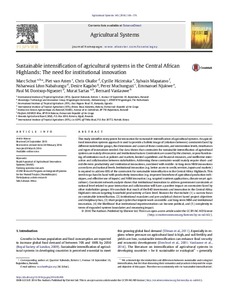| dc.contributor.author | Schut, Marc |
| dc.contributor.author | Asten, Piet J.A. van |
| dc.contributor.author | Okafor, C. |
| dc.contributor.author | Hicintuka, C. |
| dc.contributor.author | Mapatano, S. |
| dc.contributor.author | Nabahungu, N.S. |
| dc.contributor.author | Kagabo, Desire M. |
| dc.contributor.author | Muchunguzi, P. |
| dc.contributor.author | Njukwe, E. |
| dc.contributor.author | Dontsop Nguezet, Paul M. |
| dc.contributor.author | Sartas, Murat |
| dc.contributor.author | Vanlauwe, Bernard |
| dc.date.accessioned | 2019-12-04T11:03:34Z |
| dc.date.available | 2019-12-04T11:03:34Z |
| dc.date.issued | 2016-06-15 |
| dc.identifier.citation | Schut, M., van Asten, P., Okafor, C., Hicintuka, C., Mapatano, S., Nabahungu, N.L., ... & Sartas, M. (2016). Sustainable intensification of agricultural systems in the Central African Highlands: the need for institutional innovation. Agricultural Systems 145, 165-176. |
| dc.identifier.issn | 0308-521X |
| dc.identifier.uri | https://hdl.handle.net/20.500.12478/1148 |
| dc.description.abstract | This study identifies entry points for innovation for sustainable intensification of agricultural systems. An agricultural innovation systems approach is used to provide a holistic image of (relations between) constraints faced by different stakeholder groups, the dimensions and causes of these constraints, and intervention levels, timeframes and types of innovations needed. Our data shows that constraints for sustainable intensification of agricultural systems are mainly of economic and institutional nature. Constraints are caused by the absence, or poor functioning of institutions such as policies and markets, limited capabilities and financial resources, and ineffective interaction and collaboration between stakeholders. Addressing these constraints would mainly require short- and middle-term productivity and institutional innovations, combined with middle- to long-term NRM innovations across farm and national levels. Institutional innovation (e.g. better access to credit, services, inputs and markets) is required to address 69% of the constraints for sustainable intensification in the Central Africa Highlands. This needs to go hand in hand with productivity innovation (e.g. improved knowhow of agricultural production techniques, and effective use of inputs) and NRM innovation (e.g. targeted nutrient applications, climate smart agriculture). Constraint network analysis shows that institutional innovation to address government constraints at national level related to poor interaction and collaboration will have a positive impact on constraints faced by other stakeholder groups. We conclude that much of the R4D investments and innovation in the Central Africa Highlands remain targeting household productivity at farm level. Reasons for that include (1) a narrow focus on sustainable intensification, (2) institutional mandates and pre-analytical choices based project objectives and disciplinary bias, (3) short project cycles that impede work on middle- and long-term NRM and institutional innovation, (4) the likelihood that institutional experimentation can become political, and (5) complexity in terms of expanded systems boundaries and measuring impact. |
| dc.format.extent | 165-176 |
| dc.language.iso | en |
| dc.subject | Farming Systems |
| dc.title | Sustainable intensification of agricultural systems in the central African highlands: the need for institutional innovation |
| dc.type | Journal Article |
| dc.description.version | Peer Review |
| cg.contributor.crp | Integrated Systems for the Humid Tropics |
| cg.contributor.affiliation | International Institute of Tropical Agriculture |
| cg.contributor.affiliation | Wageningen University and Research Centre |
| cg.contributor.affiliation | Institut des Sciences Agronomiques du Burundi |
| cg.contributor.affiliation | Rwanda Agriculture Board |
| cg.contributor.affiliation | Platform DIOBASS Kivu, Democratic Republic of the Congo |
| cg.coverage.region | Africa |
| cg.coverage.region | Central Africa |
| cg.isijournal | ISI Journal |
| cg.authorship.types | CGIAR and developing country institute |
| cg.authorship.types | CGIAR and advanced research institute |
| cg.iitasubject | Farming Systems |
| cg.journal | Agricultural Systems |
| cg.howpublished | Formally Published |
| cg.accessibilitystatus | Open Access |
| local.dspaceid | 78195 |
| cg.targetaudience | Scientists |
| cg.identifier.doi | https://dx.doi.org/10.1016/j.agsy.2016.03.005 |

